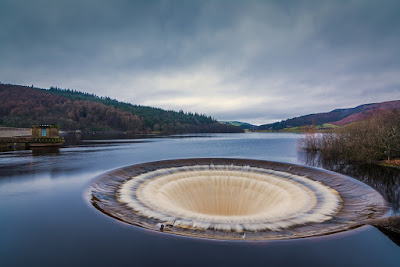On 13
th October 2018, STREAM researchers Natalia Jawiarczyk (Cohort IX) and Thomas Collin (Cohort VII) participated in the
IF Science and Ideas Festival in Oxford to engage the public with their research relating to fatbergs. Their hands-on exhibit, entitled
‘Fatbergs: the beasts beneath' took
the festival attendees on a fatberg journey, from how fatbergs form to what can be done to prevent them and how their research is solving the fatberg problem.
 |
| STREAM researchers at IF Science and Ideas Festival Oxford |
What are fatbergs?
 |
| Fatberg deposit in sewer |
Fatbergs are solid, fatty deposits that form in the sewers a result of fats, oils and greases (FOG) and non-biodegradable substances entering the sewage system. The worst culprits are cooking fats/oils, leftover food, supposedly ‘flushable’ toilet wipes and wet wipes. Fatbergs block sewage pipes and cause floods, resulting in huge problems for water companies and the public alike. A recent example of this is the infamous Whitechapel fatberg found in the London sewers. This fatberg weighed the equivalent of 11 double decker buses and was more than 250 metres long, a small sample of which Natalia and Thomas brought along to the festival to show members of the public. Currently, water companies deal with fatbergs by regular cleaning of the sewers and by monitoring water networks; however, fatbergs are able to build up quickly. Once they are found, water companies must spend a lot of time and effort digging the fatberg out, which is then disposed of in landfill. Fatbergs are an expensive problem for water companies and pose health concerns to the general public if they are not detected and removed quickly enough to prevent flooding.
How you can fight back
There are a number of things that everybody can do to help the UK’s growing fatberg problem. Here are a few key tips to help fight fatbergs:
· Scrape leftover food into the bin rather than into the sink
· Use strainers to collect any food waste in the sink and empty this into the bin
· Collect cooking oils, fats and greases and dispose of in general waste – do not pour these down the sink
· Wipe dishes with kitchen roll to keep oils and greases out of your dirty dishwater
· Dispose of wet wipes, plasters, condoms, feminine hygiene items, face wipes, toilet wipes, cotton wool, nappies and kitchen roll in bins, even if the packaging says they are flushable
 |
| Tips to fight fatbergs |
Fighting fatbergs through bio-augmentation
STREAM researcher Natalia Jawiarczyk, sponsored by Cranfield University and Severn Trent Water, is looking at the use of bio-augmentation to both prevent fatbergs from forming and break them down once they begin to form. Bio-augmentation is the addition of a bacteria culture to sewage pipes, which perform two processes: inhibition (preventing deposits from forming) and degradation (breaking down deposits). Natalia is working to improve the efficiency of these processes, by looking at both the composition of fatbergs and the sewer microclimate (e.g. temperature and pH) and how these affect the inhibition and degradation processes performed by bacterial cultures. She is looking at this first in the laboratory and then at a larger scale, using Cranfield University’s Pilot Hall.
 |
| STREAM researcher Natalia Jawiarczyk's work |
Using fatbergs to produce energy
STREAM researcher Thomas Collin, sponsored by Cranfield University and Thames Water, is looking at using anaerobic co-digestion to use the fatbergs that are removed from our sewers to produce energy. This prevents them from entering landfill and adding to our growing waste problem, while providing an alternative source of energy and fuel. In anaerobic digestion, organic material, including sludge waste from wastewater treatment plants, is added to a digestion tank. In this digestion tank, the organic material is digested by bacteria in the absence of oxygen to produce biogas and co-products. The biogas can be used as fuel, electricity production and for heating, while co-products include compost, nutrients and fertiliser. Thomas is looking at adding fats, oils and greases to this process. So far, Thomas has found that fats, oils and greases have a high energy content: 1kg of fats, oils and greases has the same energy content as 14 cans of cola or 88 hamburgers. His research means that, in the future, we may be able to turn the fatberg problem into something more positive for society, while recovering value for water companies.
 |
| STREAM researcher Thomas Collin's work |
The public engagement experience
 |
| STREAM researchers engaging the public with their work |
Aligned with the water industry insights blog, the STREAM IDC is committed to engaging the public in water industry issues and water research. Scientific research is not just for scientists as the aim of the work is to solve real-world problems, problems that are relevant to everyone.
Science and Technology Impact Officer at Cranfield University,
Zoe Griffiths, says,
“engaging people in scientific research is critical. It ensures that research is relevant to public needs and ensures that people are at the forefront of scientific research. Science should not just be left to scientists; everyone can make a real difference”
The STREAM IDC encourages its researchers to get involved in public engagement and outreach to aid their professional and personal development. STREAM IDC Programme Director
Paul Jeffrey says,
“Learning to communicate your work effectively and to different audiences is important to be successful in any career. By offering opportunities for our researchers to gain these vital communication skills, we are preparing them to be successful water professionals”
Further information on STREAM IDC outreach activities can be found
here.


























